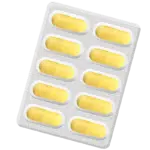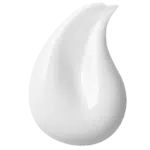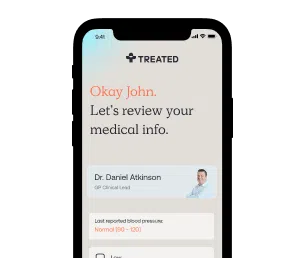Tinea Versicolor
Get antifungal treatments for tinea versicolor.
Secure delivery
UK clinicians
Tinea versicolor (also called pityriasis versicolor) is a fungal skin infection. It isn’t dangerous or contagious, but it can make some people feel self conscious and cause distress.
Order tinea versicolor treatment online to get proven results and expert advice.
Tinea versicolor is a fungal infection that affects your skin. It’s caused by the fungus Malassezia, which already lives on the skin of most adults. Tinea versicolor happens when this fungus spreads more than usual, often due to exposure to hot weather or sweating, which leads to it interfering with your skin’s pigmentation.
Tinea versicolor is purely an aesthetic condition, so it doesn’t affect your health – just your appearance. It’s characterised by discoloured, scaly patches on your skin, and it’s sometimes confused with vitiligo – a similar looking skin condition. Some people find that it makes them feel self-conscious, or affects their body image, which can cause distress.
Tinea versicolor can affect anyone, but you might have an increased risk of developing it if you’re in a warm environment, sweat excessively (sometimes known as the condition hyperhidrosis), wear tight clothing or have a weakened immune system.
It’s not contagious, so you can’t get it from someone else, or if you have it then you don’t have to worry about passing it on.
Tinea versicolor is a common infection, but it can be seen more in warmer climates than in cold ones. It’s estimated to affect up to 50% of people in hotter areas, and as few as 1.1% in colder ones. It’s also more common in teenagers and young adults, which is thought to be because you have more sebum (an oily, waxy substance) on your skin when you’re this age, which makes it a more inviting environment for the fungus to grow in.
It’s also been shown to equally affect both men and women, as well as people of different ethnicities.

How we source info.
When we present you with stats, data, opinion or a consensus, we’ll tell you where this came from. And we’ll only present data as clinically reliable if it’s come from a reputable source, such as a state or government-funded health body, a peer-reviewed medical journal, or a recognised analytics or data body. Read more in our editorial policy.
Tinea versicolor is caused by a fungus that normally lives on most peoples’ skin without causing any issues. In certain conditions it multiplies more than usual, but it’s not fully known why this happens to some people more than others.
When you’re in a warm moist environment, and your skin isn’t able to ‘breathe’ very well, it creates an environment where this fungus can multiply more, and cause the fungal infection which affects your skin's appearance.
Tinea versicolor usually affects your back, chest, neck and upper arms. It causes patches of your skin to become scaly, dry and discoloured. It usually makes lighter or darker coloured patches of your skin compared to your normal skin tone, but the patches can also appear red, brown or pink.
Not usually, no. Because it doesn’t affect your health, you won’t feel physically unwell from tinea versicolor, and it won’t lead to any other physical conditions. It can, though, cause emotional distress in some people if they don’t like how it affects their appearance.
It can also recur (keep coming back) in many people, even after they’ve treated it. And sometimes the discoloured patches can last for many months at a time.

How we source info.
When we present you with stats, data, opinion or a consensus, we’ll tell you where this came from. And we’ll only present data as clinically reliable if it’s come from a reputable source, such as a state or government-funded health body, a peer-reviewed medical journal, or a recognised analytics or data body. Read more in our editorial policy.
Tinea versicolor is usually treated with antifungal treatments. These can include shampoos, tablets and creams.
Antifungal shampoos or soaps (also called antifungal washes) are usually the first treatments prescribed, and you’ll use them around once a week – applying them to the affected area and leaving it for around five to ten minutes before washing it off. These shampoos are often available over the counter – just be sure to check that it’s suitable to treat tinea versicolor before you buy it.
If only a small area of your skin is affected, you might be prescribed an antifungal cream, and you’ll usually apply the antifungal cream to your skin once or twice a day for several weeks.
If a large area of your skin is affected, or if these other treatments haven’t worked, then you might then be prescribed antifungal tablets. Typically, you’ll take antifungal tablets once a day for up to four weeks.
The first option to treat tinea versicolor is often the use of antifungal shampoos, but this doesn’t always mean that it’ll be the best option for you. Different treatments work differently for different people. If you’re not sure which antifungal treatment will work best for you, have a chat with our clinician. They’ll ask you about your condition and health history, and will be able to recommend which treatments will suit you best.
Not always, no. Because it’s only a condition which affects your appearance rather than your health, it’s up to you whether you use treatments for it or not. But it doesn’t usually go away on it’s own, so if you want to get your skin back to how it was before you had the condition, then treatment is recommended.

How we source info.
When we present you with stats, data, opinion or a consensus, we’ll tell you where this came from. And we’ll only present data as clinically reliable if it’s come from a reputable source, such as a state or government-funded health body, a peer-reviewed medical journal, or a recognised analytics or data body. Read more in our editorial policy.
Have something specific you want to know? Search our info below, or ask our experts a question if you can’t find what you’re looking for.
Immunology of Diseases Associated with Malassezia Species. Clinical Microbiology Reviews, 15(1), pp.21–57.
Tinea (Pityriasis) Versicolor. [online] PubMed.

Antifungal capsule used off-label to treat fungal skin infections. Taken once a week.

Effective antifungal treatment that you rub into your skin.

Oral antifungal capsules for fungal infections. Ideally used when topical options haven’t worked.

Topical antifungal treatment to treat fungal skin infections. Contains 2% ketoconazole.

Medicated shampoo to treat fungal infections. Contains 2.5% selenium sulphide.

Registered with GMC (No. 4624794)
Meet Daniel
Registered with GPhC (No. 2202465)
Meet Sanjeda
Registered with GPhC (No. 2070724)
Meet Craig
Always read the leaflet that comes with your medication and tell us about any side effects you get.
We know health, but you know you.
Our experts tell you what’s safe, but you decide what’s best.
Answer a few questions and tell us about yourself. Get tailored advice from our clinicians so you can choose better.

Choose your treatment and how often you have it delivered.

We know things change. It’s the nature of life. We’ll check in regularly to make sure your treatment is still right for you.
Pause. Change. Skip. Start again. Any time you like.
Here are some other things we can help with.
Choose from our range of tablets and solutions. Get ongoing care and support from our experts.
Stop smoking treatments that can help you kick the habit forever, and reduce your risk of disease.
Tablets or injections. Tailored weight loss treatments combined with ongoing support from our experts.
We're making healthcare more about you. Sign up to our newsletter for personalised health articles that make a difference.
Disclaimer: The information provided on this page is not a substitute for professional medical advice, diagnosis, or treatment. If you have any questions or concerns about your health, please talk to a doctor.
We couldn't find what you're looking for.
Here's everything we treat. Or, if you're looking for something we don't have yet, you can suggest something.
If there’s a particular treatment or condition you’re looking for, tell us and we’ll look into it for you.
Submit your question here, or tell us if you’ve found an issue on our site.
We’ll get back to you very soon. We aim to respond to all queries in one working day.
You’re signed up to our newsletter. Keep an eye on your inbox for our latest update.
By clicking 'Subscribe now' you're agreeing to our Privacy Policy.
We’ve sent you an email asking you to confirm your email address.